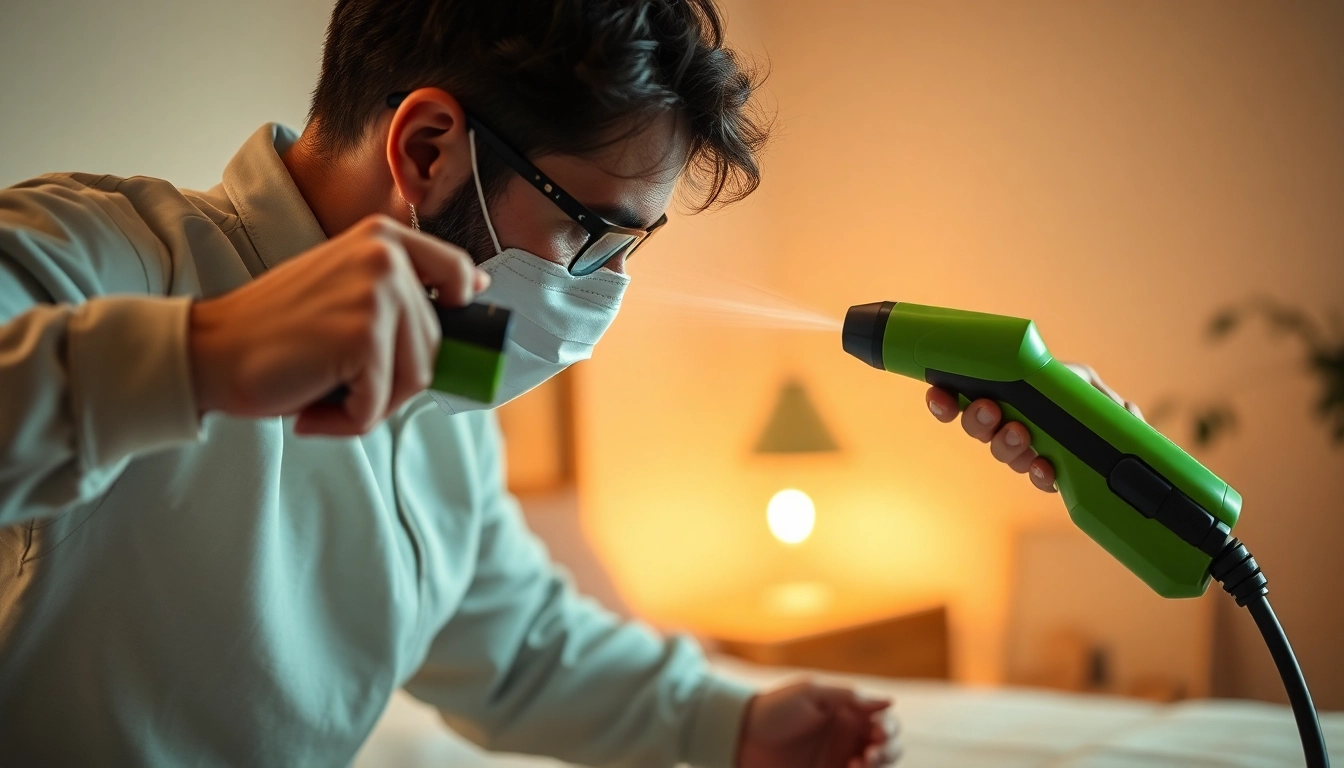Understanding Bed Bugs
What Are Bed Bugs?
Bed bugs are small, wingless insects belonging to the family Cimicidae. They thrive on the blood of warm-blooded hosts, primarily humans. Adult bed bugs are about the size of an apple seed, measuring approximately 5 to 7 mm in length. Their bodies are flat and oval-shaped, which allows them to hide in cracks and crevices, making them difficult to detect. Their coloration ranges from light brown to reddish-brown, especially after feeding. These pests are primarily nocturnal, feeding on their hosts while they sleep, which adds to their stealthy nature.
Signs of Infestation
Identifying a bed bug infestation can be challenging due to their elusive behavior. However, several signs can indicate their presence:
- Dark Spots: Fecal spots or molted skins are often found on bedding, mattresses, and walls.
- Bites: Small, itchy welts or bumps on the skin are common indicators, typically appearing in a linear pattern.
- Eggs and Nymphs: Bed bug eggs are tiny, white, and about the size of a pinhead, often hidden in creases of mattresses.
- Musty Odor: A sweet, musty smell can develop in heavily infested areas due to secretions from the bed bugs.
If you notice any of these signs, it’s crucial to take immediate action, as bed bugs reproduce rapidly, leading to larger infestations over time. Early detection is key for effective bed bug pest control.
Health Risks Related to Bed Bugs
While bed bugs are not known to transmit diseases like other pests, their bites can lead to various health issues:
- Skin Reactions: Most people experience red, itchy welts that can become infected if scratched.
- Sleep Disorders: Anxiety and stress from a bed bug infestation can cause sleep disturbances, leading to insomnia and other health concerns.
- Allergic Reactions: In severe cases, individuals may develop allergic reactions to bed bug saliva, requiring medical attention.
Why Professional Bed Bug Pest Control is Essential
Effective Treatments vs. DIY Methods
Many homeowners consider do-it-yourself (DIY) methods to eradicate bed bugs, ranging from sprays and powders to home remedies. However, these methods often prove ineffective for various reasons:
- Inadequate Coverage: DIY solutions may not penetrate all hiding spots where bed bugs reside, such as inside mattress seams or behind baseboards.
- Resistance: Bed bugs have shown resistance to many over-the-counter insecticides, reducing their effectiveness.
- Incomplete Treatments: Many DIY approaches fail to tackle all life stages of bed bugs, leading to persistent infestations.
Professional pest control services employ Integrated Pest Management (IPM) strategies that combine multiple approaches—chemical and non-chemical—to effectively target bed bugs at all life stages.
Long-term Solutions for Bed Bug Problems
When facing a bed bug infestation, long-term solutions are vital. Professionals provide comprehensive treatments, including:
- Heat Treatments: Raising the room temperature to levels lethal for bed bugs can effectively eliminate them.
- Chemical Treatments: Registered insecticides specifically designed for bed bugs ensure targeted action against resistant populations.
- Follow-up Inspections: Re-inspections after treatment are crucial to ensure that the infestation has been effectively eradicated.
These tailored treatments not only eradicate bed bugs but also prevent future infestations, making them a wise investment for peace of mind.
The Cost-Benefit of Hiring Professionals
While hiring exterminators may initially seem costly, it is essential to analyze the long-term benefits:
- Time Efficiency: Professionals can often resolve infestations more quickly than DIY methods, saving residents time and hassle.
- Preventive Measures: Experts provide advice and strategies on how to prevent future infestations, ultimately saving money on repeat treatments.
- Guaranteed Results: Many pest control companies offer satisfaction guarantees, ensuring treatment effectiveness or free re-treatments.
Preparing Your Home for Bed Bug Pest Control
Initial Steps Before Treatment
Preparing your home before a professional treatment can significantly enhance the effectiveness of bed bug pest control:
- Clear Clutter: Remove excess items from the infested area to allow pests to be effectively treated and monitored.
- Strip Bedding: Wash bed linens, curtains, and clothing in hot water, then dry them on high heat to kill any bed bugs and eggs.
- Move Furniture: Pull beds and furniture away from walls to expose potential hiding places for bed bugs.
Cleaning and Decluttering Strategies
Effective cleaning and decluttering are critical in the fight against bed bugs:
- Vacuuming: Thoroughly vacuum carpets, floors, and upholstered furniture to remove visible bugs, eggs, and fecal matter. Dispose of the vacuum bag immediately in a sealed plastic bag.
- Sealing Cracks and Crevices: Use caulk to seal openings in walls, baseboards, and around electrical outlets to eliminate hiding spots.
- Storage Solutions: Utilize plastic storage bins for clothing and bedding to help prevent cross-contamination during treatment.
How to Protect Your Belongings
Protecting your belongings during bed bug treatments is essential. Here are several tips:
- Date-Stamp Packaging: Place any items that cannot be washed in sealed plastic bags to prevent the spread of bed bugs.
- Remove Items from Bedrooms: Limit items in the bedroom during treatment to prevent reintroducing bed bugs post-treatment.
- Transport Care: If you’re in the process of moving, check all furniture and boxes for bed bugs to avoid spreading them elsewhere.
Post-Treatment Tips to Prevent Bed Bugs
Monitoring for Recurrence
Even after treatment, vigilance is essential to ensure that bed bugs do not return:
- Inspection: Regularly inspect sleeping areas and furniture for signs of bed bugs for at least a few months after treatment.
- Monitoring Devices: Use bed bug monitors or traps to catch any lingering bugs or newly introduced ones.
Best Practices for Home Maintenance
Simple home maintenance practices can significantly reduce the risk of future infestations:
- Regular Cleaning: Maintain a cleaning routine that includes vacuuming, dusting, and laundering bedding and curtains regularly.
- Be Cautious During Travel: Inspect accommodations for bed bugs and keep luggage off the bed and floor.
- No Second-Hand Furniture: Avoid bringing in used furniture that has not been thoroughly inspected for pests.
Using Bed Bug Deterrents Effectively
Several deterrent products can be effective in reducing the chance of infestations:
- Bed Bug Covers: Use encasements on mattresses and box springs to trap bed bugs and prevent bites.
- Desiccants: Products containing diatomaceous earth can help dehydrate and kill bed bugs and their eggs in targeted areas.
- Pesticides: Consider using EPA-registered insecticides as a preventative measure, but follow application directions carefully to avoid health risks.
Frequently Asked Questions About Bed Bug Pest Control
Can I Get Rid of Bed Bugs Myself?
While some people attempt DIY methods for bed bug removal, these strategies are often ineffective and can lead to further infestation. Professional pest control services provide more effective, thorough solutions to ensure complete eradication.
How Long Does Treatment Take to Work?
The timeline for effectiveness can vary based on the severity of the infestation and treatment methods used. Heat treatments may yield immediate results, while chemical treatments may take longer and require follow-up visits. Typically, expect results within several weeks, with professionals monitoring the situation post-treatment.
What Should I Do if Bed Bugs Return?
If bed bugs return after treatment, contact your pest control provider immediately for a follow-up assessment. They may recommend additional treatments or adjustments to strategies used initially to ensure the infestation is eradicated.



